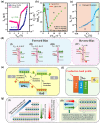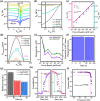Synergistically Engineered All Van der Waals GaS-WSe2 Photodiodes: Approaching Near-Unity Polychromatic Linearity for Multifunctional Optoelectronics
- PMID: 40123324
- PMCID: PMC12051824
- DOI: 10.1002/smll.202410841
Synergistically Engineered All Van der Waals GaS-WSe2 Photodiodes: Approaching Near-Unity Polychromatic Linearity for Multifunctional Optoelectronics
Abstract
Van der Waals (vdW) heterojunctions represent a significant frontier in post-Moore era optoelectronics, especially in optimizing photosensor performance through multivariate approaches. Here synergistic engineering of GaS-WSe2 all-vdW photodiodes is investigated, which exhibit broadband detection (275-1064 nm), multispectral unity approaching linearity, alongside a substantial linear dynamic range (LDR) of 106.78 dB. Additionally, the photodiodes achieve a remarkable on/off ratio of 105 and rapid response edges of 545/471 µs under a 405 nm pulsed source, exhibiting ultralow light detection capabilities (dark currents ∼fA), culminating in a peak responsivity of 376.78 mA W-1 and a detectivity of 4.12 × 10¹¹ Jones under 450 nm illumination, complemented by an external quantum efficiency (EQE) of 30% and a fill factor of ≈0.33. Based on the analysis of multiple all-vdW devices, the importance of Fermi-level pinning free metal-2D interface engineering that enables effective modulation of the Schottky barrier height via vdW metal contacts is highlighted and meticulous thickness-engineered layers in developing a robust depletion region within the type-II GaS-WSe2 heterojunction are employed, ultimately achieving a favorable balance among photocarrier generation recombination, separation, transport, and extraction. This comprehensive investigation sets the stage for future developments in critically engineered next-generation vdW optoelectronic devices.
Keywords: Fermi‐level pinning; GaS–WSe2 heterostructure; all van der Waals; broadband photodiode; photovoltaic; type‐II heterojunction; van der Waals contact.
© 2025 The Author(s). Small published by Wiley‐VCH GmbH.
Conflict of interest statement
The authors declare no conflict of interest.
Figures






References
-
- Britnell L., Ribeiro R. M., Eckmann A., Jalil R., Belle B. D., Mishchenko A., Kim Y.‐J., Gorbachev R. V., Georgiou T., Morozov S. V., Grigorenko A. N., Geim A. K., Casiraghi C., Castro Neto A. H., Novoselov K. S., Science 2013, 340, 1311. - PubMed
-
- Wong J., Jariwala D., Tagliabue G., Tat K., Davoyan A. R., Sherrott M. C., Atwater H. A., ACS Nano 2017, 11, 7230. - PubMed
-
- Hu P., Wang L., Yoon M., Zhang J., Feng W., Wang X., Wen Z., Idrobo J. C., Miyamoto Y., Geohegan D. B., Xiao K., Nano Lett. 2013, 13, 1649. - PubMed
-
- Chitara B., Ya'Akobovitz A., Nanoscale 2018, 10, 13022. - PubMed
-
- Araujo F. D. V., Oliveira V. V., Gadelha A. C., Carvalho T. C. V., Fernandes T. F. D., Silva F. W. N., Longuinhos R., Ribeiro‐Soares J., Jorio A., Souza Filho A. G., Alencar R. S., Viana B. C., Nanotechnology 2020, 31, 495702. - PubMed
Grants and funding
- 1-CD6V/Photonic Research Institute
- 1-CD8V/Research Institute for Advanced Manufacturing
- 1-CDK6/Research Institute for Advanced Manufacturing
- The Hong Kong Polytechnic University, Hong Kong, China
- JCYJ20241202130542054/Science, Technology and Innovation Commission of Shenzhen Municipality
- JCYJ20210324141206017/Science, Technology and Innovation Commission of Shenzhen Municipality
- JCYJ20241202130542054/The Hong Kong Polytechnic University Shenzhen Research Institute, Shenzhen, China
- JCYJ20210324141206017/The Hong Kong Polytechnic University Shenzhen Research Institute, Shenzhen, China
LinkOut - more resources
Full Text Sources
Miscellaneous

